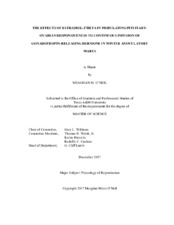| dc.description.abstract | Continuous infusion with native gonadotropin-releasing hormone (GnRH) restores follicular growth and ovulation in approximately 85% of winter anovulatory mares. However, the potential role of estradiol-17β (E2) in enhancing pituitary responsiveness to GnRH during this transitional process is unclear. Moreover, the contribution of follicle-stimulating hormone (FSH) to the overall response has not been studied. Objectives herein were to test the hypotheses that (1) continuous treatment with either a low or high dose of E2 enhances pituitary responsiveness to continuous infusion of native GnRH, and (2) the pattern of FSH secretion mimics that of LH. Twenty-four winter anovulatory mares were stratified by body weight and body condition score, and assigned randomly to 1 of 4 treatments (n = 6/treatment) in early February: 1) Control; Silastic® subcutaneous (S.C.) sham pump, 2) GnRH; native GnRH in saline via 14-day Alzet® osmotic pump (100 μg/h, S.C.), 3) GnRH + High E2; GnRH as in 2 plus Compudose® E2 implant, (25.7-mg, S.C.), and 4) GnRH + Low E2; GnRH as in 2 and 3 plus 1/4-length E2 implant (6.425-mg, S.C.). Plasma concentrations of LH, FSH, E2,
estrone sulfate, and progesterone were measured in daily blood samples. Mares developing 35-mm follicles were induced to ovulate with human chorionic gonadotropin (hCG). Mares not ovulating within 14 days received a second 14-day GnRH pump. Although acute increases in uterine edema observed within 48 hours indicated implant functionality, plasma E2 and estrone sulfate were increased primarily in associationwith a large, Continuous infusion with native gonadotropin-releasing hormone (GnRH) restores follicular growth and ovulation in approximately 85% of winter anovulatory mares. However, the potential role of estradiol-17β (E2) in enhancing pituitary responsiveness to GnRH during this transitional process is unclear. Moreover, the contribution of follicle-stimulating hormone (FSH) to the overall response has not been studied. Objectives herein were to test the hypotheses that (1) continuous treatment with either a low or high dose of E2 enhances pituitary responsiveness to continuous infusion of native GnRH, and (2) the pattern of FSH secretion mimics that of LH. Twenty-four winter anovulatory mares were stratified by body weight and body condition score, and assigned randomly to 1 of 4 treatments (n = 6/treatment) in early February: 1) Control; Silastic® subcutaneous (S.C.) sham pump, 2) GnRH; native GnRH in saline via 14-day Alzet® osmotic pump (100 μg/h, S.C.), 3) GnRH + High E2; GnRH as in 2 plus Compudose® E2 implant, (25.7-mg, S.C.), and 4) GnRH + Low E2; GnRH as in 2 and 3 plus 1/4-length E2 implant (6.425-mg, S.C.). Plasma concentrations of LH, FSH, E2, estrone sulfate, and progesterone were measured in daily blood samples. Mares developing 35-mm follicles were induced to ovulate with human chorionic gonadotropin (hCG). Mares not ovulating within 14 days received a second 14-day GnRH pump. Although acute increases in uterine edema observed within 48 hours indicated implant
functionality, plasma E2 and estrone sulfate were increased primarily in associationwith a large, dominant follicle. Plasma LH was increased in all GnRH-treated mares, regardless of ovarian response, but was unaffected by E2. By Day 28, 6/6 GnRH, 5/6 GnRH + Low E2, 2/6 GnRH + High E2, and 0/6 Control mares developed a 35-mm follicle and were induced to ovulate. A peak of FSH was observed in response to all GnRH treatments at 24 hours, with plasma FSH returning to baseline by day 4. Therefore, the hypotheses were not supported as the subcutaneous E2 implants failed to enhance responsiveness of mares to GnRH and the release of FSH in response to GnRH infusion did not mimic the LH release pattern. | en |


